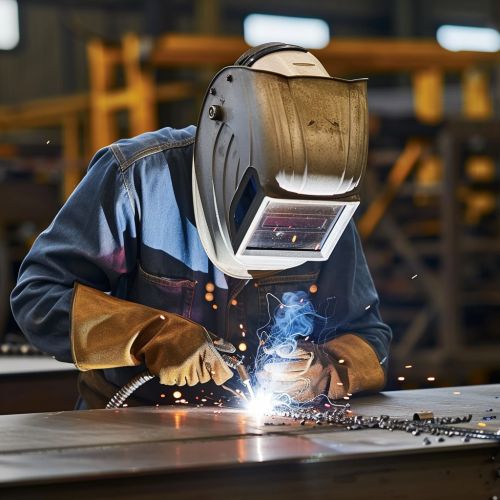Stick Welding
Introduction
Stick welding, also known as Shielded Metal Arc Welding (SMAW) or manual metal arc welding (MMAW), is a manual arc welding process that uses a consumable electrode coated in flux to lay the weld. It is one of the simplest and most versatile welding methods, widely used in various industries such as construction, manufacturing, and shipbuilding.


Process
The process of stick welding involves creating an electric current between the metal to be welded and the electrode. The electric arc produced by this current melts the electrode, creating a molten metal that is deposited onto the base metal. The flux coating on the electrode also melts, forming a gas that shields the weld from atmospheric contamination.
Equipment
Stick welding requires a power source, an electrode holder, a ground clamp, and electrodes. The power source can be either alternating current (AC) or direct current (DC), and the choice depends on the electrode type and the welding application. The electrode holder holds the electrode and conducts the current to it, while the ground clamp completes the electrical circuit.
Electrodes
The electrodes used in stick welding are made of a core wire coated with a layer of flux. The core wire conducts the electric current and provides filler metal for the weld, while the flux coating protects the weld from atmospheric contamination and influences the characteristics of the weld. Electrodes come in a variety of types, each designed for specific welding positions, metals, and applications.
Advantages and Disadvantages
Stick welding has several advantages, including simplicity, versatility, and cost-effectiveness. It can be used on a wide range of metals, in various positions, and in different environments. It also requires less equipment and setup than other welding methods, making it suitable for field work and repair jobs.
However, stick welding also has some disadvantages. It produces a lot of smoke and spatter, which can be hazardous and requires cleanup. It also has a lower deposition rate and efficiency compared to other welding methods, and the quality of the weld depends heavily on the skill of the welder.
Safety
Safety is a major concern in stick welding, as it involves high temperatures, electric current, and harmful fumes. Welders must wear protective clothing, including a welding helmet, gloves, and a welding jacket, to protect themselves from heat, sparks, and ultraviolet radiation. They must also ensure proper ventilation to avoid inhaling harmful fumes, and follow safety guidelines to prevent electric shock and fire hazards.
Applications
Stick welding is used in a wide range of industries and applications, from construction and manufacturing to repair and maintenance. It is commonly used for welding carbon steel, stainless steel, and cast iron, and can be used for both thick and thin materials. It is also suitable for outdoor and field work, as it is less sensitive to wind and rain compared to other welding methods.
